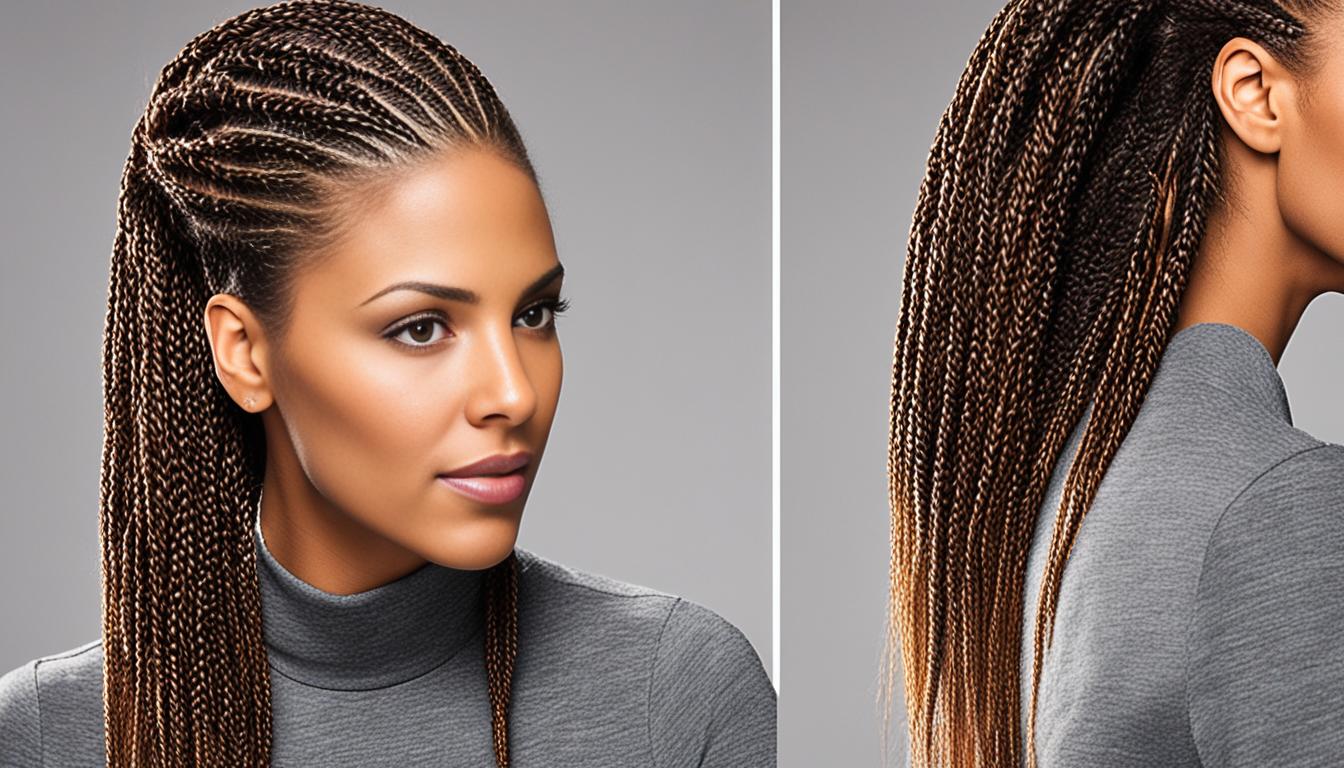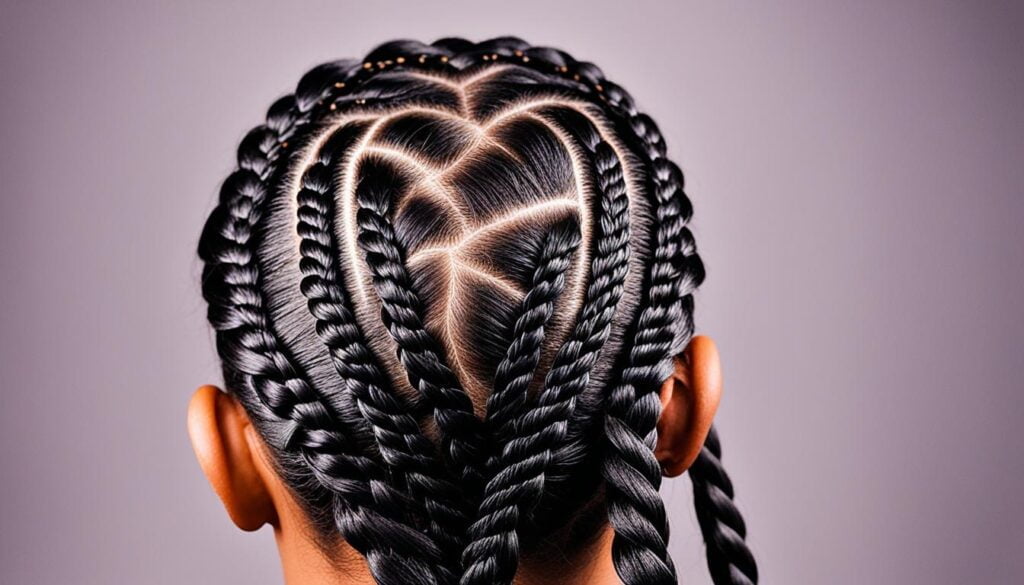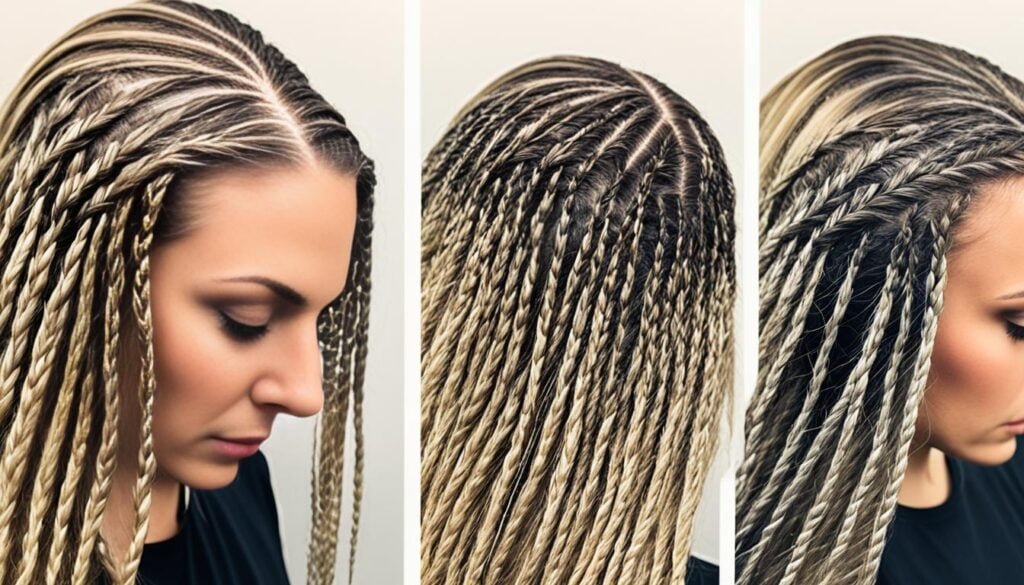
Are braids your go-to hairstyle for a trendy and convenient look? While braids can be stylish and practical, it’s important to be aware of their potential downsides. Are braids damaging your hair and causing scalp issues? Do they really cause breakage and hair loss? And what about that itchy scalp? Let’s uncover the truth about the drawbacks of braids and find out how to mitigate them.
Key Takeaways:
- Braids can cause hair breakage and breakage around the edges if installed too tightly or on weakened hair.
- Braids that are too large or small are more likely to cause breakage to the natural hair.
- Braids can be expensive and time-consuming to install and remove.
- Improper braiding techniques and care can lead to discomfort and potential scalp damage.
- Maintaining and caring for braids is crucial to prevent damage and potential hair loss.
Hair breakage and breakage around the edges
One of the potential downsides of wearing braids is the risk of hair breakage and breakage around the edges. Braids that are installed too tightly or if the hair is already weakened can lead to this issue. It’s important to ensure that the braids are not pulling on the hair too tightly to prevent breakage.
Braids that are too large and heavy or very small, such as micro braids, are more likely to cause breakage as well. These types of braids put additional strain on the natural hair, increasing the risk of damage and breakage.
Proper technique and skillful execution are crucial to avoid excessive tension on the hair. A skilled stylist will know how to balance the tightness of the braids to minimize the risk of breakage.
Here’s an overview of the factors that contribute to hair breakage and breakage around the edges:
| Factors | Description |
|---|---|
| Tightness of braids | If the braids are installed too tightly, it can weaken the hair and lead to breakage. |
| Braid size | Large and heavy braids, as well as very small braids like micro braids, can put excessive strain on the natural hair, causing breakage. |
Cost and time commitment
When considering getting braids, it’s important to factor in both the cost and time commitment involved.
Braids can be a pricey hairstyle, with the cost varying depending on the length and size of the braids. The intricacy of the braiding pattern and the type of extensions used can also affect the overall cost. However, it’s essential to remember that braids can be a long-lasting style, so the initial investment may be worth it in the long run.
Additionally, the installation and removal of braids can be time-consuming. The process can take anywhere from 6 to 8 hours or even longer, depending on the complexity of the desired braid style. It’s crucial to allocate enough time for the appointment and plan accordingly to avoid feeling rushed or compromising the quality of the braids.
While braids can be pricey and time-consuming, many people find that the benefits outweigh the disadvantages. Braids provide a versatile and low-maintenance hairstyle that can last for several weeks with proper care. However, it’s essential to carefully consider the financial and time commitments before deciding to get braids.
| Pros | Cons |
|---|---|
| – Versatile styling options | – Braids can be pricey |
| – Low-maintenance | – Time-consuming installation and removal |
| – Long-lasting style |

Discomfort and potential scalp damage
Braids can be a stylish and convenient hairstyle, but if not done or cared for correctly, they can cause discomfort and potential damage to the scalp. One common issue that individuals may experience is scalp issues from braids, such as an itchy scalp.
The added weight of braids and extensions can put pressure on the scalp and hair follicles, leading to discomfort. When braids are installed too tightly or if there is unnecessary tension on the scalp, it can result in scalp irritation and soreness.
To prevent scalp issues and discomfort, it is crucial to choose a skilled stylist who knows how to braid without causing unnecessary tension. They should be able to assess the right amount of tension to apply during the braiding process. Additionally, opting for braids that are not excessively heavy can help minimize the strain on the scalp.
It is important to make sure that the stylist is experienced and knows how to braid without causing unnecessary tension on the scalp.
Proper care and maintenance of braids are also essential to avoid scalp issues. Regularly moisturizing and washing the scalp can help alleviate dryness and itchiness. Using a lightweight oil or leave-in conditioner can provide much-needed hydration without weighing down the hair or irritating the scalp.
Furthermore, individuals should avoid leaving braids in for extended periods, as this can lead to scalp tension and potential hair damage. It is recommended to visit a professional stylist to have the braids removed and reinstalled periodically.
**
Tips for Minimizing Scalp Discomfort:
**
- Choose a skilled stylist who understands the importance of maintaining scalp health.
- Opt for braids that are not excessively heavy to minimize strain on the scalp.
- Regularly moisturize and wash the scalp to prevent dryness and itchiness.
- Avoid keeping braids in for extended periods and consult a professional stylist for removal and reinstallation.
To get a better understanding, let’s take a look at the table below, which highlights some common scalp issues associated with braids:
| Scalp Issue | Description |
|---|---|
| Itchy Scalp | Caused by dryness, dehydration, or product buildup on the scalp. |
| Sore Scalp | Result of excessive tension or tight braiding, leading to discomfort. |
| Scalp Tenderness | Occurs when the scalp is irritated or inflamed due to braiding techniques or hair extensions. |
By taking the necessary precautions and properly caring for the scalp, individuals can minimize discomfort and potential scalp damage while enjoying the benefits of stylish braids.

The importance of maintenance
Proper maintenance is essential to ensure the longevity and health of your braids. Neglecting regular care can lead to damage to your hair and potential hair loss. By following a few simple steps, you can keep your braids looking fresh and prevent any scalp issues that may arise.
Washing
It is important to maintain clean braids to prevent product buildup, which can weigh down the hair and lead to damage. To wash your braids:
- Dilute a sulfate-free shampoo with water in a spray bottle.
- Spray the mixture onto your scalp, focusing on the roots.
- Gently massage your scalp to remove any dirt or oil.
- Rinse thoroughly with lukewarm water. Avoid using hot water as it can cause the braids to unravel.
Moisturizing
Braids can be drying to your natural hair, so it is important to keep them moisturized. Consider using a lightweight leave-in conditioner or a moisturizing spray to keep your hair hydrated. Apply the product to your braids and gently massage it into your scalp and hair.
Covering at night
While sleeping, your braids can get tangled or frizzy if left unprotected. It is recommended to cover your braids with a satin or silk scarf or sleep on a satin pillowcase. These materials are gentle on the hair and help to retain moisture, reducing the risk of breakage or damage.
Professional maintenance
Regular touch-ups by a professional stylist can help ensure that your braids remain secure and properly maintained. They can also address any potential issues or concerns you may have, such as braids that are too tight or causing discomfort.
By following these maintenance tips, you can enjoy your braids while minimizing the risk of hair damage and hair loss.

| Benefits of Regular Maintenance |
|---|
| Prevents hair breakage |
| Reduces the risk of hair loss |
| Keeps braids looking fresh and neat |
| Maintains the health of your scalp |
Conclusion
Despite the potential disadvantages of braids, such as hair breakage and discomfort, they remain a popular and versatile hairstyle choice that offers both protection and styling options. To prevent damage and minimize the drawbacks associated with braids, it is vital to follow a few key practices.
Firstly, it is crucial to choose a skilled stylist who understands how to install braids without excessive tension or tightness. Avoiding braids that are too heavy or tight can help prevent breakage and scalp discomfort.
Additionally, proper maintenance and care are essential to safeguard the health of your hair and scalp. This includes regular washing, moisturization, and covering the braids at night to avoid friction and minimize the risk of an itchy scalp.
By employing these preventive measures, individuals can enjoy the benefits of braids while minimizing potential damage and discomfort. By working with a qualified stylist and maintaining a consistent hair care routine, braids can be a beautiful and protective style that enhances your overall look.






